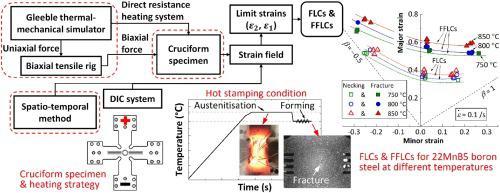Journal of Materials Processing Technology ( IF 6.3 ) Pub Date : 2021-12-28 , DOI: 10.1016/j.jmatprotec.2021.117481 Ruiqiang Zhang 1 , Zhusheng Shi 1 , Victoria A. Yardley 1 , Jianguo Lin 1

|
Boron steel is the most widely used material in hot stamping applications for forming automotive body panels with complex shapes and ultra-high strength. Due to the high austenitic transformation temperatures and the complex thermal cycle required for hot stamping, however, it is difficult to evaluate the formability of the material using standard punch test methods developed for room-temperature testing. In this study, a high-temperature modification of a recently developed biaxial test method has been used to determine, in a single test procedure and for the first time, forming limit curves (FLCs) and fracture forming limit curves (FFLCs) for 22MnB5 boron steel sheet with a thickness of 1.5 mm under thermal conditions that are representative of industrial hot stamping processes. A direct resistance heating strategy has been developed, and a recently proposed cruciform specimen design has been modified for high-temperature use. For tests with target temperatures in the range of 750 to 925 °C, the resulting test specimens had the highest temperature at the specimen centre and a temperature difference of less than 45 °C in the gauge area and fracture occurred close to the centre of this area under all test conditions investigated. Limit strains at the onset of necking and at fracture for the material have been determined by applying digital image correlation (DIC) to obtain full-field strain measurements, providing an experimental foundation for constructing both FLCs and FFLCs for industrial applications.
中文翻译:

热冲压条件下硼钢薄板颈缩及断裂极限试验研究
硼钢是热冲压应用中使用最广泛的材料,用于形成形状复杂和超高强度的汽车车身面板。然而,由于高奥氏体转变温度和热冲压所需的复杂热循环,使用为室温测试开发的标准冲压测试方法很难评估材料的可成形性。在这项研究中,对最近开发的双轴测试方法进行了高温改进,首次在单一测试程序中确定了 22MnB5 硼的成形极限曲线 (FLC) 和断裂成形极限曲线 (FFLC)在代表工业热冲压工艺的热条件下厚度为 1.5 mm 的钢板。开发了直接电阻加热策略,最近提出的十字形试样设计已针对高温使用进行了修改。对于目标温度在 750 至 925°C 范围内的测试,所得试样在试样中心处的温度最高,并且在测量区域的温差小于 45°C,并且在靠近该中心的位置发生断裂在所有测试条件下调查的区域。通过应用数字图像相关 (DIC) 获得全场应变测量,确定了材料在颈缩开始和断裂时的极限应变,为构建用于工业应用的 FLC 和 FFLC 提供了实验基础。得到的测试样品在样品中心具有最高温度,并且在测量区域的温差小于 45°C,并且在所有研究的测试条件下,靠近该区域的中心发生断裂。通过应用数字图像相关 (DIC) 获得全场应变测量,确定了材料在颈缩开始和断裂时的极限应变,为构建用于工业应用的 FLC 和 FFLC 提供了实验基础。得到的测试样品在样品中心具有最高温度,并且在测量区域的温差小于 45°C,并且在所有研究的测试条件下,靠近该区域的中心发生断裂。通过应用数字图像相关 (DIC) 获得全场应变测量,确定了材料在颈缩开始和断裂时的极限应变,为构建用于工业应用的 FLC 和 FFLC 提供了实验基础。


























 京公网安备 11010802027423号
京公网安备 11010802027423号